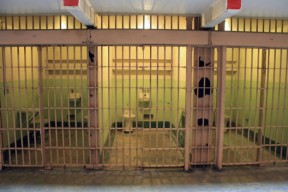 From Longreads…
From Longreads…
From 1995 to 2000, the number of individuals held in solitary increased by 40 percent.
The heir to Alcatraz was the U.S. Penitentiary in Marion, Illinois, which opened in 1963, the same year the notorious island prison was closed. Marion was built to hold “difficult to control” men in the federal prison system, and over the next decade it evolved into the “end of the line” prison for individuals deemed dangerous or disruptive. In 1973, H-Unit at Marion was officially designated the Long-Term Control Unit, with all those held in the unit subjected to around-the-clock solitary confinement and a “behavior modification” program. In the ensuing years, the federal Bureau of Prisons floated several proposals to turn the entire prison into a control unit.
On October 22, 1983, in two separate incidents, two corrections officers at Marion were killed by men held in the Control Unit. Although the perpetrators were immediately identified, the entire prison was placed on lockdown—and essentially, never taken off—and the supermax prison was born.
While the Marion lockdown may have provided the model for modern-day solitary confinement on a broad scale, a number of factors, all of them closely linked to the rise of mass incarceration, provided the impetus. These included, first and foremost, a rapid growth in incarceration rates due to increased criminalization of behavior, lengthening sentences, and the widespread elimination or diminution of parole. The United States now incarcerates approximately one in one hundred adults, a rate that significantly outpaces Russia and China and dwarfs all European nations.
During the same period, beginning in the late 1970s, prisons largely abandoned any notion of rehabilitation. Meanwhile, the United States was undergoing a massive shift toward the deinstitutionalization of people with mental illness. They were supposed to receive treatment and support in the community once they left psychiatric hospitals, but such services were grossly lacking.
These developments led to extreme prison overcrowding, and with it, a rise in prison violence. Because they had abandoned faith in rehabilitation, prison administrators’ only remaining strategy was to crack down harder, piling punishment upon punishment, and more extreme confinement on top of confinement.
From The Osborne Association…
There is no single story that describes what it is like for a child to have a parent who is incarcerated. The experience depends on diverse factors, including the quality of the parent-child relationship prior to incarceration, the degree of household stability following the incarceration, and the child’s age, developmental level, and individual personality.
◘ International human rights advocates have called parental incarceration “the greatest threat to child well-being in the U.S.” 1
◘ While many of the risk factors children of incarcerated parents experience may be related to parental substance abuse, mental health, inadequate education, or other challenges, parental incarceration increases the risk of children living in poverty or experiencing household instability independent of these other problems. 2
◘ A misperception exists that children of incarcerated parents are more likely to be incarcerated than their peers, and are predisposed to criminal activity. There is no basis for this in existing research. 3
◘ Some assume that the removal of a “bad” (“criminal”) parent will improve the situation for the child. However, parental incarceration more often intensifies and compounds, rather than alleviates, the challenges children face.
◘ Parental incarceration is now recognized as an “adverse childhood experience” (ACE); it is distinguished from other adverse childhood experiences by the unique combination of trauma, shame, and stigma. 4
◘ Separation due to a parent’s incarceration can be as painful as other forms of parental loss and can be even more complicated because of the stigma, ambiguity, and lack of social support and compassion that accompanies it.
◘ Visits with parents (in most cases) help to heal the pain of the loss and are critical to children’s well-being. However, visiting opportunities can be few and far between due to the distant location of prisons and the costs associated with visits.
◘ For children whose mothers are incarcerated, there is an increased likelihood of instability and that the children are in, or may enter, foster care.
national stats on children and incarcerated parents
◘ More than 2.7 million children in the U.S. have an incarcerated parent and approximately 10 million children have experienced parental incarceration at some point in their lives. 5
◘ One in 9 African American children (11.4%), 1 in 28 Hispanic children (3.5%), and 1 in 57 white children (1.8%) in the United States have an incarcerated parent. 6 ◘ Nationally, there are more than 120,000 incarcerated mothers and 1.1 million incarcerated fathers who are parents with minor children (ages 0-17). 7
◘ A national study conducted in 1998 estimated that of parents arrested, 67% were handcuffed in front of their children, 27% reported weapons drawn in front of their children, 4.3% reported a physical struggle, and 3.2% reported the use of pepper spray. 8
◘ In 2004, approximately 59% of parents in a state correctional facility and 45% of parents in a federal correctional facility reported never having had a personal visit from their children. 9
